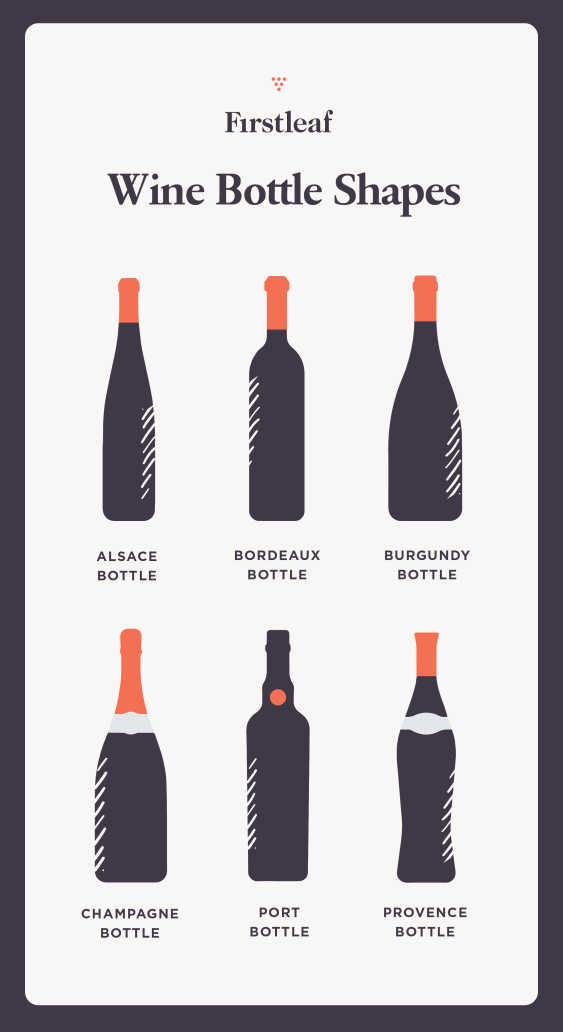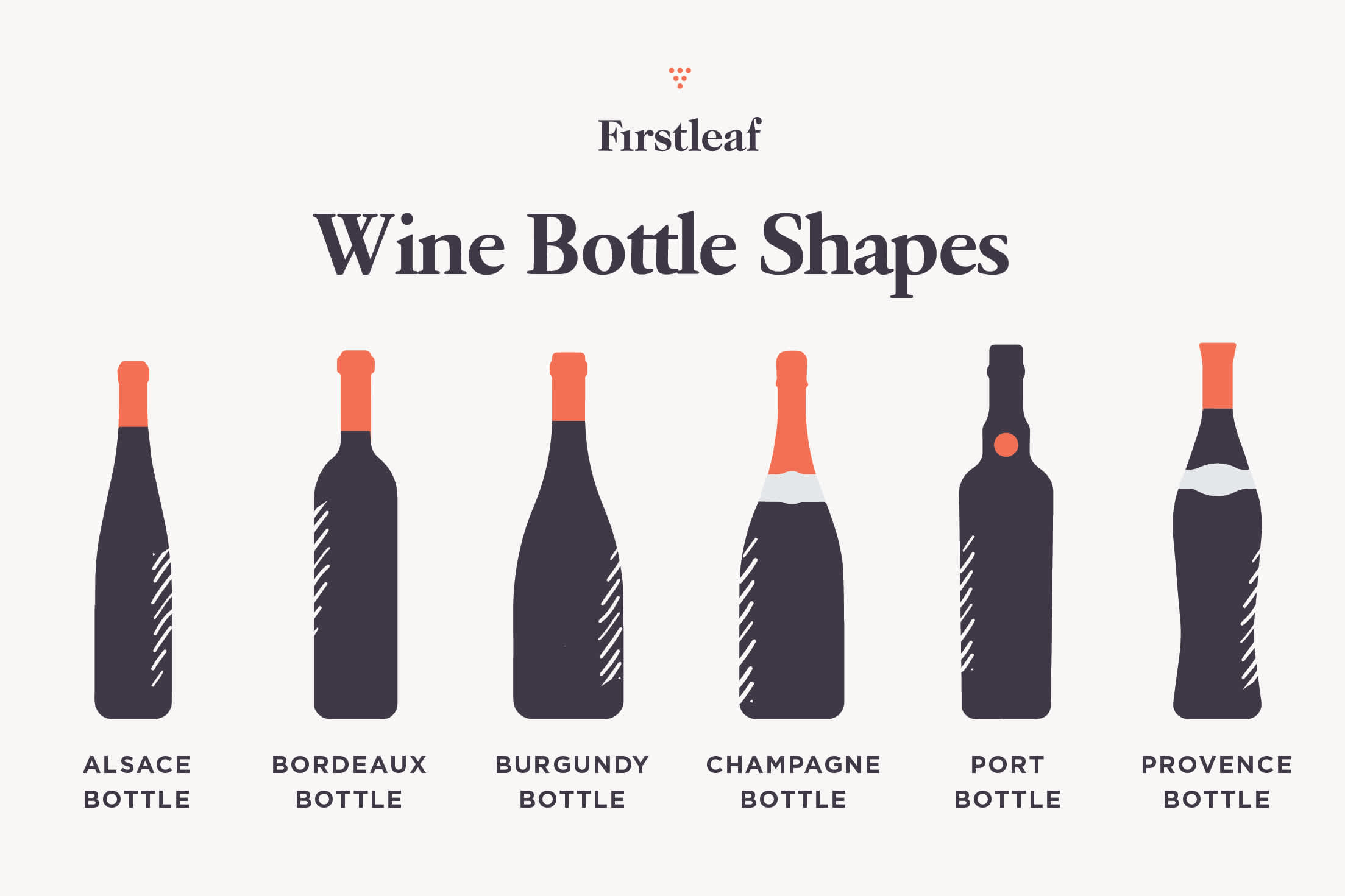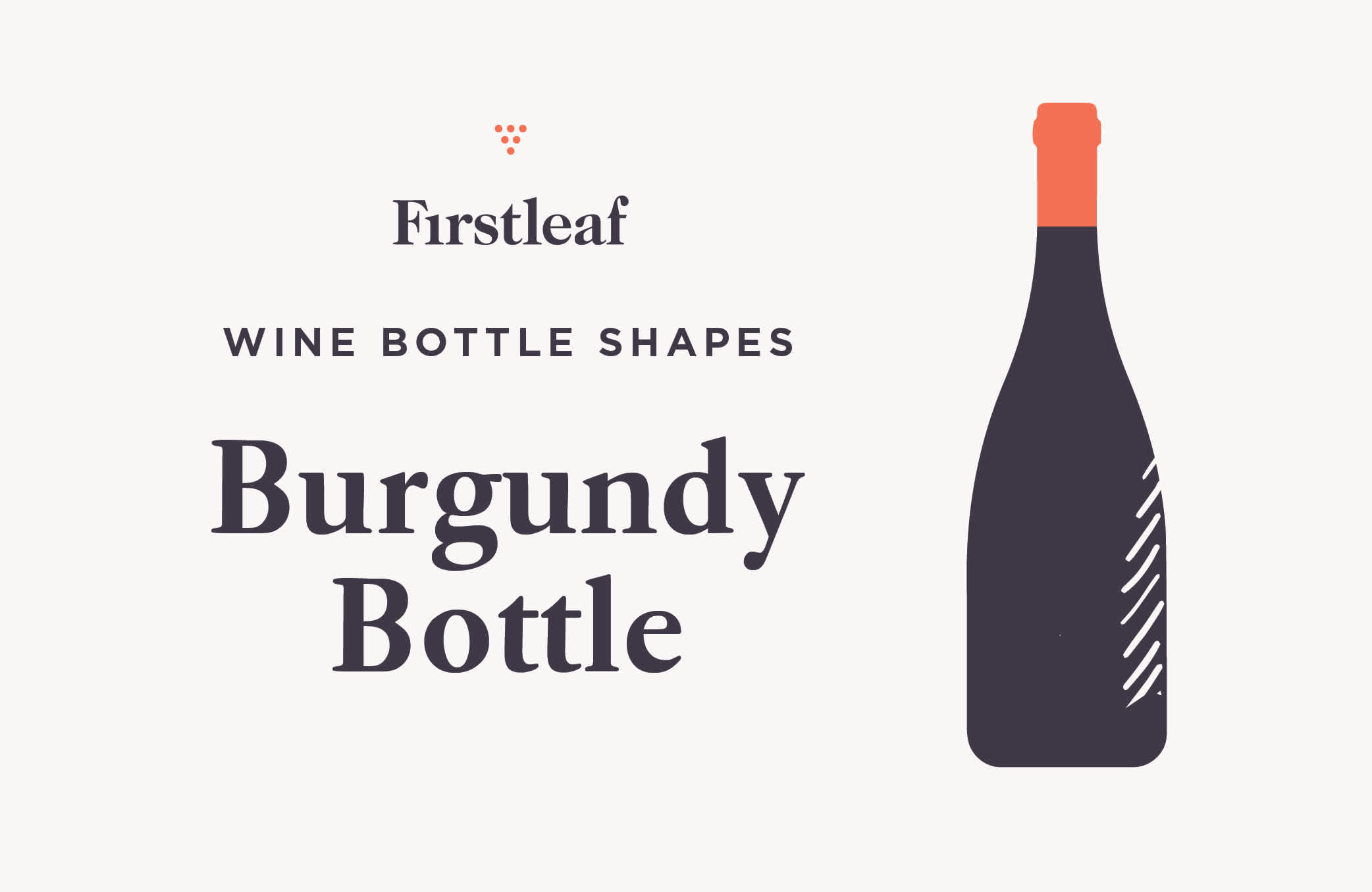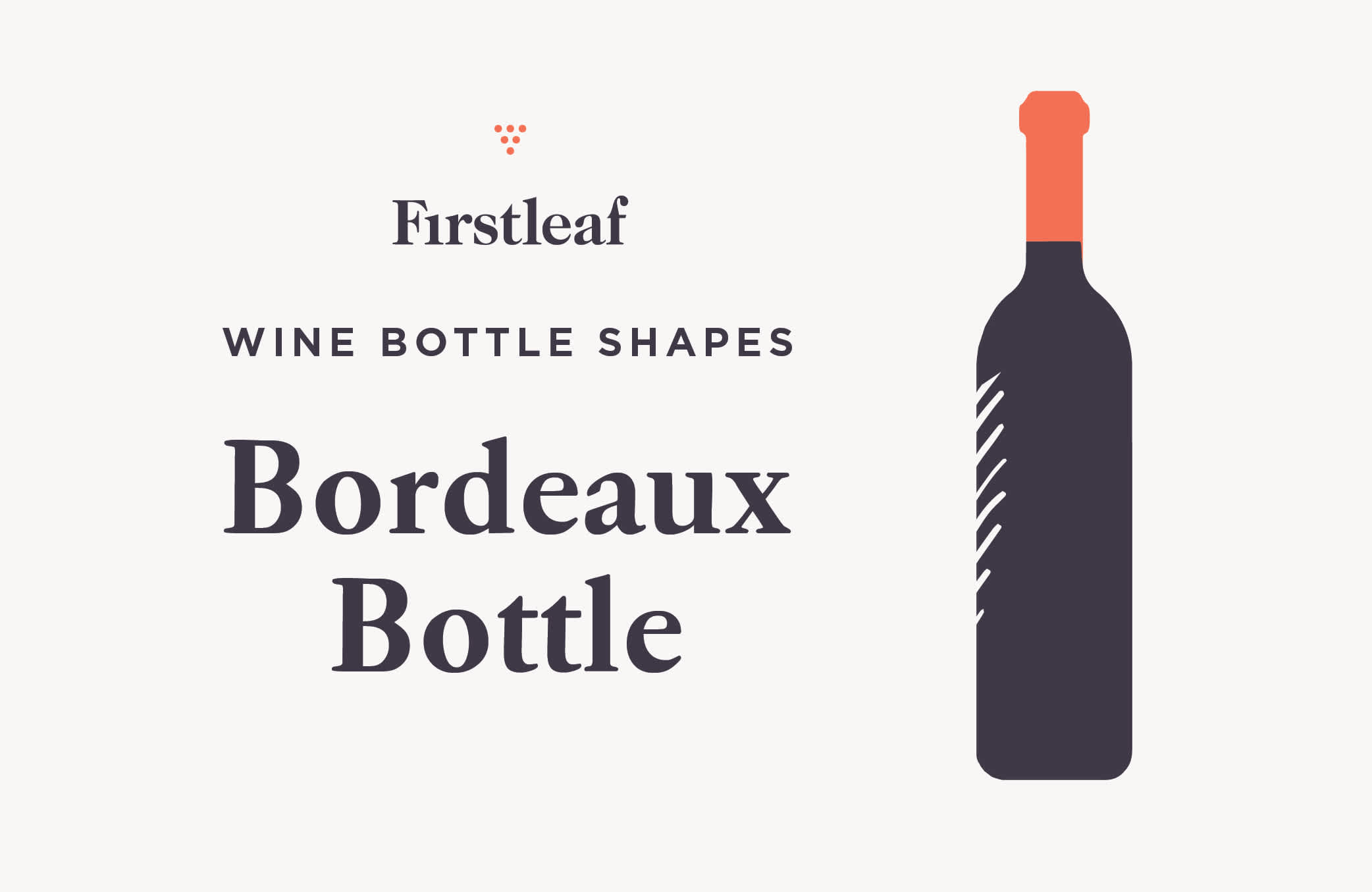Guide to Wine Bottle Shapes
Color, shape, and size all play a part in the tactile drinking experience and the science behind our favorite beverage.
While wine bottle shape and size may appear somewhat random to a casual drinker, there‘s a method to the madness behind the glass. Different shapes can communicate a winemaker’s stylistic intention, and different sizes can provide different experiences for the consumer.
The correct bottle stored in ideal conditions can expand the lifespan of a wine considerably. Color, shape, and size all play a part in the tactile drinking experience and the science behind our favorite beverage.
We’ve put together the ultimate guide to wine bottle shapes and sizes so that you can pick up on the clues the next time you are trying to decide what to open.
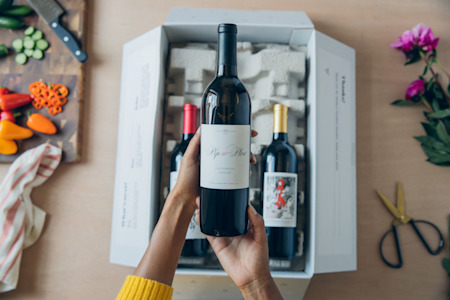
Sign up for the Club Today
Join Firstleaf to taste delicious wines from all over the world and learn more about these grapes. The club has featured amazing examples, take the quiz to get the pairings for your individual palate.
Take Our QuizIN THIS ARTICLE:
A Short History of Glass Bottles
The history of wine bottle shapes is inextricably linked with technological developments in glassblowing. The oldest wine storage vessels were large clay jars called amphorae. These jars were often lined with beeswax and used for winemaking in situ and occasionally for transport. Today some natural winemakers are reviving the tradition of amphorae-based winemaking and are turning out some exciting wines.
There is archeological evidence that the ancient Egyptians and people of India made the earliest examples of glass, but it was in the Roman Empire that glassblowing finally flourished. Their winemaking primarily utilized amphorae, but some scholars believe they used glass for wine storage and service. Sadly, this technology was lost with the fall of the Roman Empire.
It wasn’t until the 1500s that the Venetians rediscovered and improved upon the Roman techniques. The methods for making Cristallo glass were a jealously guarded secret that inspired some of the earliest acts of espionage and totalitarian state controls to maintain Venetian glassmaking supremacy.
A lumber shortage in Britain in the 17th century led to the adoption of coal to fuel furnaces. This practice unexpectedly produced a much stronger and darker glass that was used for wine storage and wine service. Over the next two hundred years, glass blowing and cork technology evolved together, and bottles went from being rounded to having straight sides, which allowed for “binning,” also known as sideways storage.
By the 19th century, the standard wine bottle shape emerged with a shorter neck, sloped or rounded shoulders, and a punt (the indentation of the bottom of a bottle) for strength and stability. Today we see different bottles for different types of wine.
Modern Bottle Shapes
By the 1970s, most producers had settled on a few standardized and modern bottle shapes with paper wine labels to tell the consumer where the wine came from and who made it. Today the different wine bottle shapes signal the stylistic intentions of a winemaker, which we will dig into a bit more under each bottle type.
Burgundy Bottle
The Burgundy bottle came to prominence in the Pinot Noir, and Chardonnay dominated fields of Burgundy, France. This type of bottle is used to hold wines that age gracefully and without much sediment development, which is one of the reasons the bottle features sloped shoulders instead of the precipitous drop seen in a Bordeaux wine bottle. For a winemaker to use this type of wine bottle means that they are either working with the grapes of Burgundy or are making wine with similar grapes.
Gamay, Grenache, Syrah, Cinsault, Mencia, and Listan Negro are red grapes often found in Burgundy bottles. White varietal wines that use this type of bottle include Sauvignon Blanc, Chenin Blanc, and Pinot Gris.
Interestingly this shape is often seen in the Rhône Valley but with stamped or otherwise decoratively imprinted embellishments.
Champagne Bottle
A Champagne bottle is shaped similarly to a Burgundy bottle but features a deep punt and thicker glass that can withstand the high pressure created by secondary fermentation. The only other notable difference is that the lip is often wider to strengthen the closure of a muselet (the cage over the cork). The bottle is often medium to dark green and is used by sparkling winemakers all over the world.
Bordeaux Wine Bottle
This bottle originated in Bordeaux, France, and is found in almost every wine region on earth, especially in conjunction with the world’s two most planted grape varieties: Cabernet Sauvignon and Merlot. The high shoulders are the distinctive feature and are used to collect the sediment that many highly structured red wine throws as it ages. Many white wines use the Bordeaux bottle as well. It is fashionable, if not ubiquitous. Sauvignon Blanc can come in either Burgundy or Bordeaux bottles, as can Chardonnay and Pinot Grigio. Big red wines like Tempranillo, Malbec, and Shiraz are also commonly found in Bordeaux bottles.

Find Your Next Bottle of Wine Today
Shop award-winning white and red wines in our wine store and browse by color, region, varietal, and more.
Shop Wines NowGermanic Bottle
Alternately referred to as an Alsatian, Hock, Riesling, or Mosel bottle, this tall and slender wine bottle is used for white wines from the mountainous regions of Europe. In Germany, along the vineyards on the Rhine, it is used for Riesling. In Alsace, France, it is used for Gewurztraminer and Riesling. You are much less likely to encounter this shape than Bordeaux or Burgundy, but it is worth noting.
Other Shapes
It should be acknowledged that there are some outliers. Madeira bottles, Vin Jaune bottles from the Jura, and the Fiasco’s of Chianti are all so region-specific that they aren’t included in the standard modern bottle shape, even though they do pop up from time to time.
Bottle Sizes
Surprisingly it wasn’t until the 1970s that bottle size was regulated in Europe. “One bottle = 750 ml” was quickly adopted by winemakers everywhere as the world standard.
You might be surprised that there are all sizes of specialty bottles in addition to the multiple shapes. They run from the almost-never-encountered-outside-of-an-airplane piccolo to the larger bottles such as the mythical Sovereign bottle that holds 34 standard bottles of wine. Confusingly Bordeaux and Champagne / Burgundy use different names for the same bottle size. We will list them as (Bdx) and (Ch) to avoid confusion.
Here are the sizes of bottle you might realistically encounter in the world of wine:
Piccolo / Split - A quarter bottle, most often seen in Champagne.
Demi / Half Bottle
“50 cl“ - This 500 ml bottle is 2/3rds of a standard bottle and is used for sweet wines like Sauternes and Tokaji.
Standard Bottle Size
Magnum - This size fits two standard bottles of wine. Every wine from here and up is considered ideal for aging. The less oxygen present in the total volume of wine, the less it can oxidize the wine.
Marie Jeanne (Bdx)- This size fits three standard bottles of wine and is typically only found in Bordeaux.
Double-Magnum (Bdx) / Jeroboam (Ch) - This size fits four standard bottles of wine.
Jeroboam (Bdx) / Rehoboam (Ch) - This size fits six standard bottles of wine.
Imperiale (Bdx) / Methuselah (Ch) - This size fits eight standard bottles of wine.
Salmanazar (Ch) - This size fits twelve standard bottles of wine.
Balthazar (Ch) - This size fits sixteen standard bottles of wine.
Nebuchadnezzar (Ch) - This size fits twenty standard bottles of wine.
Closing
While a few outliers that aren’t mentioned in this article exist, it is unlikely that you will run into them. If you do, let us know! We’d love to add to this list or hear about your wine-drinking experience and we hope you enjoyed upping your wine education with this article. Cheers!

Take Our Quiz Today
Get award-winning delicious wines from all over the world shipped straight to your door. Take the quiz to get the perfect pairings for your holiday season.
Take The Quiz TodayIN THIS ARTICLE
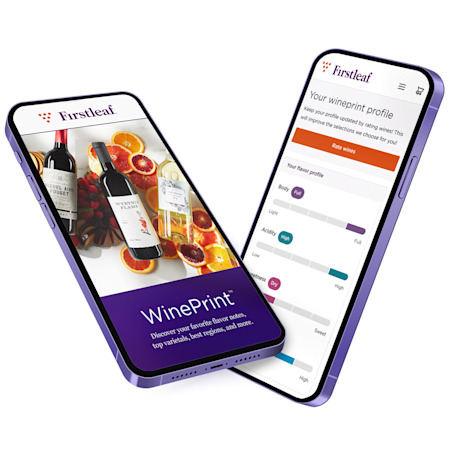
WinePrint™ by Firstleaf
Are you looking to learn more about your wine preferences? Check out our Wine Print for an in-depth look at your personal tasting profile. Discover your favorite wines, varietals, regions, and tasting notes and get personalized recommendations wherever you are.
Learn More